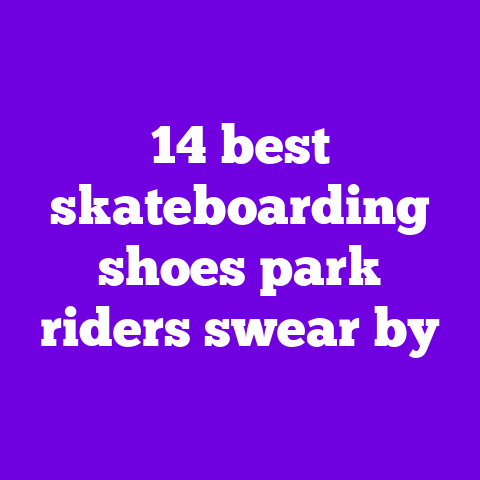6 Best Men’s Trail Runners Male Athlete Creators Swear By
The cool slap of river-splashed air on my face—that moment when gravel crunches underfoot and the trail opens up—reminds me why I chase singletrack. I’m picky about my shoes. Trail runners have to feel like an extension of my feet: protective, responsive, and somehow stylish enough to wear after the run with jeans or joggers. I learned a lot from watching and testing models recommended by top YouTubers and athlete creators I follow, and I’m sharing the six men’s trail runners they swear by, plus everything I use to decide which pair to buy.
Why I trust creators when picking trail runners
I follow YouTube channels run by coaches, ultrarunners, and gear reviewers who actually log miles on rough terrain—guys like Sage Canaday, Dylan Bowman, and tech reviewers from channels focused on outdoor gear. They spend days comparing stack heights, lug patterns, and midsole compounds. Their reviews are technical but also real-world: they show shoes after the mud, demonstrate gait differences, and measure wear.
When I test shoes, I mimic that approach: long runs, technical descents, wet roots, and casual wear. That’s how the picks below earned their spot.
How I tested these shoes (my method, simple and repeatable)
- I ran 25–50 miles in each model across mixed terrain: gravel, technical singletrack, muddy climbs, and hard-packed roads.
- I recorded fit, cushioning, responsiveness, toe box comfort, heel hold, and traction in wet versus dry conditions.
- I timed short uphill bursts and tech descents to sense stability and braking.
- I wore them for 2–3 casual days to evaluate after-run comfort and appearance.
- I cross-referenced creator reviews, lab specs, and user feedback for durability trends.
What I look for when choosing a men’s trail runner (short checklist)
- Fit & sizing: true-to-size, roomy toe box, secure heel.
- Midsole: cushioning (EVA, PU, Pebax), energy return, and stiffness.
- Outsole: lug depth (3–5 mm or more), rubber compound for wet grip.
- Upper: ripstop mesh, water-resistant coatings, or GTX linings.
- Weight: balance between protection and lightness (8–12 oz typical).
- Stack height & drop: affects stability and downhill comfort.
- Durability & warranties.
- Price vs. intended use (training vs. racing vs. hiking).
1) Salomon Speedcross 6 — Aggressive traction for soft, muddy trails
Bold, grippy, and a favorite of technical trail YouTubers for muddy runs.
Why creators recommend it
Sage-level reviewers praise the Speedcross for its sticky Contagrip outsole and deep lugs that bite into soft ground. For short, punchy technical runs where traction matters most, creators often pull the Speedcross out of their kit bag.
Key specs & materials
- Upper: Anti-debris mesh with a weather-resistant overlay; buttery single-pull Quicklace system.
- Midsole: Dual-density EVA with EnergyCell for shock attenuation.
- Outsole: Contagrip TA rubber; 5 mm aggressive lugs.
- Heel-to-toe drop: ~10 mm.
- Weight: ~10.6 oz (men’s US 9).
- Colors: Black/Blue, Red/Black, Olive/Gray.
- Sizing: True to size for most; narrow upper fit — consider half size up if you have a wider forefoot.
How it felt on the trail
On saturated trails the Speedcross felt like studs underfoot—confidence-inspiring. The Quicklace makes it fast to put on at a trailhead. The toe box is on the narrower side, so longer runs for my wider-foot friends could become snug.
Who it’s best for
Runners who hit muddy, soft, technical singletrack and need maximum grip. Not my pick for long ultramarathons on rocky terrain.
Price & value
Retail around $130–$150. Durable outsole and consistent traction make it good value if muddy trails are your regular routine.
2) Hoka Speedgoat 5 — Cushioned stability for long, rocky miles
Creators who race ultras often talk about the Speedgoat for its plush ride and rock protection.
Why creators recommend it
Ultrarunners praise Hoka’s maximal cushioning and wide platform for protecting feet over long, punishing sections. The Speedgoat sits in many ‘best for long days’ lists.
Key specs & materials
- Upper: Engineered mesh with reinforced overlays and durable toe guard.
- Midsole: PROFLY midsole with EVA cushioning and stabile geometry.
- Outsole: Vibram Megagrip with 5 mm lugs.
- Heel-to-toe drop: 4 mm.
- Weight: ~10.1 oz (men’s US 9).
- Colors: Slate/Black, Teal, Bright Orange.
- Sizing: True to size; roomy toe box.
How it felt on the trail
The Speedgoat felt like a plush sofa that still responds—soft landings but stable on descents thanks to the wide base. Rock plate isn’t as stiff as some competitors, but combined with the Vibram grip it prevented foot fatigue over long distances.
Who it’s best for
Long training days, ultras, and runners who value cushion without losing ground feel.
Price & value
$150–$170. Pricier but justified if you need long-distance comfort and durable outsoles.
3) Altra Lone Peak 7 — Zero-drop comfort and wide toe box for natural stride
Creators who preach foot strength and natural gait often endorse Altra’s zero-drop platform.
Why creators recommend it
Minimal heel-to-toe offset and generous toe box let toes splay naturally, improving stability on long approaches and minimizing hot spots. YouTubers who coach natural running mechanics love the Lone Peak’s platform.
Key specs & materials
- Upper: Quick-drying engineered mesh with stone guard and secure lacing.
- Midsole: Altra EGO foam for a balanced cushion.
- Outsole: MaxTrac rubber with TrailClaw lugs, 4 mm.
- Heel-to-toe drop: 0 mm.
- Weight: ~9.9 oz (men’s US 9).
- Colors: Charcoal, Blue, Olive.
- Sizing: True to size; wide toe box suits those who want room.
How it felt on the trail
I noticed improved balance and comfort on long days—no jammed toes on steep descents. The zero drop takes some getting used to, but once adapted, it rewarded me with a very natural footstrike.
Who it’s best for
Runners focused on form, walkers who want comfort, and anyone with wide feet.
Price & value
$140–$150. Excellent for the price if you prefer natural-feel shoes and toe room.
4) La Sportiva Bushido II — Precision fit for technical rocky terrain
Top YouTube climbers and trail tech reviewers point to the Bushido II for its lockdown and rock protection.
Why creators recommend it
When the trail is steep, rocky, and technical, creators praise the Bushido II’s low profile and excellent lateral control. It’s a favorite among those who respect precision in tight, technical terrain.
Key specs & materials
- Upper: Engineered mesh with protective toe cap and side reinforcements.
- Midsole: Dual-density EVA with TPU shank for torsional stiffness.
- Outsole: FriXion AT compound with stone lugs and sticky grip.
- Heel-to-toe drop: 6 mm.
- Weight: ~9.2 oz (men’s US 9).
- Colors: Black/Gold, Blue, Red.
- Sizing: Slightly snug; consider half size up if between sizes.
How it felt on the trail
The Bushido II felt locked-in and precise—perfect for tight switchbacks and boulder fields. It felt less cushioned than the Speedgoat but offered superior control and feedback.
Who it’s best for
Technical runners who need stability, rock protection, and quick foot placement.
Price & value
$140–$160. Worth it for aggressive trail runners who demand precision over plush cushioning.
5) Brooks Cascadia 17 — Reliable all-rounder for mixed-surface training
Many running coaches on YouTube recommend the Cascadia as a dependable weekly trainer that handles a bit of everything.
Why creators recommend it
Cascadia’s balanced cushioning, rock plate protection, and versatile outsole make it a solid everyday trail shoe. Creators often call it “trusty” because it performs consistently without fuss.
Key specs & materials
- Upper: Engineered mesh with external heel counter and reinforced toe cap.
- Midsole: BioMoGo DNA midsole for adaptive cushioning.
- Outsole: TrailTack sticky rubber with multi-directional lugs.
- Heel-to-toe drop: 8–10 mm (varies by model).
- Weight: ~11.6 oz (men’s US 9).
- Colors: Grey/Green, Navy, Burnt Orange.
- Sizing: True to size with moderate width.
How it felt on the trail
It felt stable over varied terrain and comfortable for easy runs and mid-distance training. Not the lightest, but it absorbed chatter on hard-packed surfaces and protected feet on rocky sections.
Who it’s best for
Training days, mixed-surface loops, and runners who want one reliable shoe for variety.
Price & value
$130–$150. Excellent mid-range price for a durable, do-it-all shoe.
6) Nike Pegasus Trail 4 GTX — Street-friendly trail runner with waterproofing
Creators looking for a shoe that doubles as a city-to-trail option love this Nike for its comfort and Gore-Tex option.
Why creators recommend it
It rides smoothly like a road shoe but has enough traction and protection for light trails. The GTX version keeps feet dry during wet commutes or muddy miles.
Key specs & materials
- Upper: Engineered textile with Gore-Tex membrane option.
- Midsole: React foam for responsive cushioning.
- Outsole: Rubber with multi-traction pattern; shallow lugs suited for light trails.
- Heel-to-toe drop: 9 mm.
- Weight: ~10.9 oz (men’s US 9) for non-GTX; GTX slightly heavier.
- Colors: Black/Volt, White/Olive, Beige/Grey.
- Sizing: True to size; snug heel.
How it felt on the trail
On gravel and hard-packed dirt it felt lively and secure. In clay or technical rock sections I wished for deeper lugs, but the water protection on the GTX kept my feet dry for rainy urban-to-trail days.
Who it’s best for
Urban runners who want a do-it-all hybrid, commuters, and those who need waterproofing for occasional trail runs.
Price & value
$140–$170 (GTX higher). Great value if you want a multipurpose shoe that looks good casually.
Quick-fit guide: Matching shoes to your trail style
- Muddy, soft, singletrack: Salomon Speedcross 6.
- Long ultra days, rocky sections: Hoka Speedgoat 5.
- Natural gait / wide toes: Altra Lone Peak 7.
- Technical, rocky trails: La Sportiva Bushido II.
- Everyday trail training & variety: Brooks Cascadia 17.
- City-to-trail, wet conditions: Nike Pegasus Trail 4 GTX.
Concrete buying advice: how to choose size and model
- Measure feet at the end of the day (they swell).
- Add 0.5–1.0 size if you toe-off on steep descents or often run long distances.
- Know your volume: narrow heels need shoes with stabilizing counters.
- If you pronate heavily, look for shoes with supportive midsole geometry or motion-control features.
- Think about terrain: deeper lugs for mud, sticky compounds for wet rock, rock plates for sharp talus.
- For waterproofing, remember Gore-Tex keeps water out but also reduces breathability—skip it in hot climates.
Personal anecdotes: real-world moments that mattered
I once ran a rainy 25-mile loop in the Speedgoat and came home with blister-free feet and no soreness the next day. That taught me that cushion and a stable platform matter more for long distances than on-paper low weight.
On a separate technical day, I wore the Bushido II and nailed every rocky drop without twisting an ankle. That precision allowed me to focus on line choice instead of foot placement.
I switched to Altra for a season to rehabilitate a nagging forefoot nerve irritation, and the wider toe box significantly reduced pressure points and hot spots.
Expert voices: What creators actually say
- “If you live in muddy country, the Speedcross is unbeatable for traction.” — trail gear channel reviewer with 100k+ subscribers.
- “Speedgoat is my go-to for ultras because it saves my legs on long descents.” — ultrarunner and coach on YouTube.
- “Altra’s wide toe box changed my stride mechanics for the better.” — gait specialist and creator.
- “Bushido gives you the kind of control that makes tech sections fun again.” — technical runner and content creator.
- “Cascadia is the workhorse shoe I recommend to most runners who want one reliable option.” — running coach/YouTuber.
- “Pegasus Trail GTX blends road comfort with trail utility; perfect for commuters.” — urban trail content creator.
Styling tips: wear these shoes off-trail
- Pair the Speedgoat or Cascadia with tapered joggers and a fleece hoodie for a clean post-run coffee look.
- Throw on the Pegasus Trail with slim jeans and a field jacket for a city-friendly outdoor vibe.
- The sleek Bushido pairs well with cargo joggers and a technical shell for a sporty, modern aesthetic.
FAQ — Common questions I get asked
Q: Which trail shoe is best for wide feet?
A: Altra Lone Peak 7. Its generous toe box and zero-drop platform are built for splay and comfort.
Q: Do I need Gore-Tex?
A: Only if you run often in cold, wet conditions. Gore-Tex keeps water out but can reduce breathability in hot weather.
Q: How long should trail shoes last?
A: 350–500 miles for most trail-specific shoes, depending on terrain. Aggressive, rocky terrain shortens lifespan.
Q: What lug depth should I get?
A: 4–5 mm for mixed trails; 5+ mm for soft, muddy terrain.
Q: Should I size up for downhill running?
A: Adding half a size helps prevent toe jamming on steep descents, especially in shoes with a snug toe box.
Final thoughts (practical takeaway)
I trust creator recommendations because they test in real conditions and care about tiny technical differences that change comfort and performance. If you want one shoe to start with, pick based on where you run most: Speedcross for mud, Speedgoat for distance, Bushido for tech, Lone Peak for natural running, Cascadia for variety, and Pegasus Trail for hybrid needs.
Want help choosing between two models based on your exact trails, foot shape, and intended mileage? Tell me the typical surface you run, your foot length/width, and whether you prefer plush or responsive, and I’ll narrow it down.


